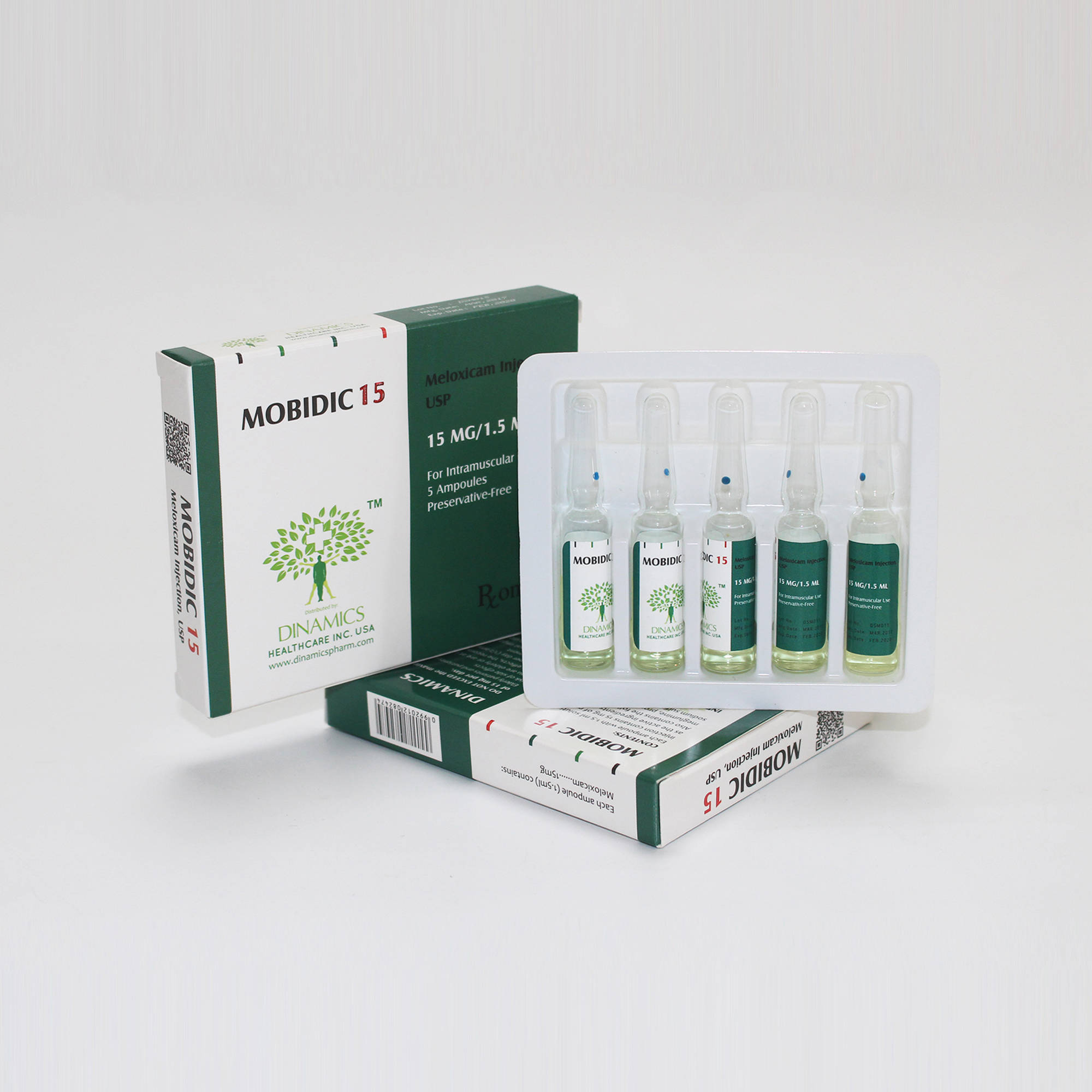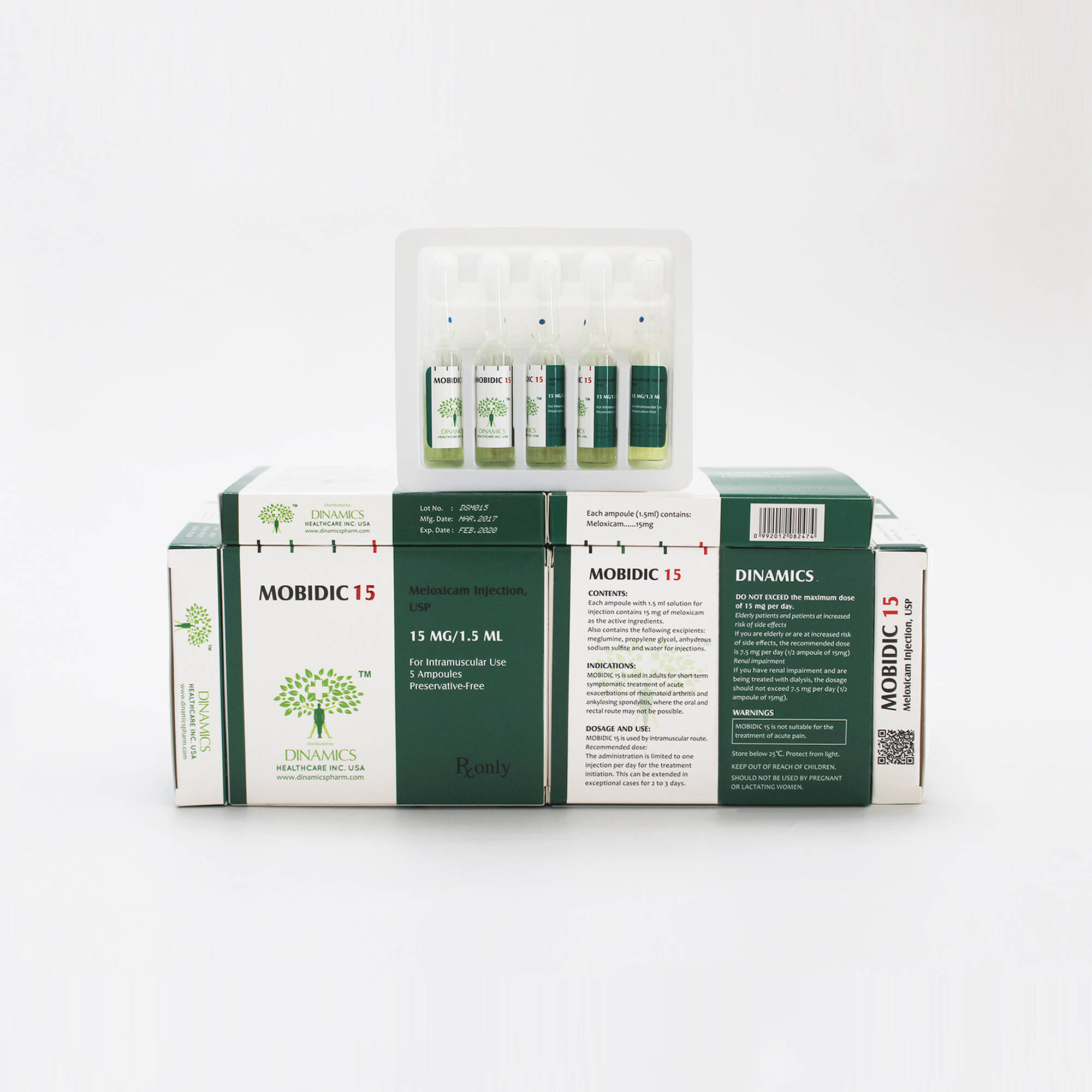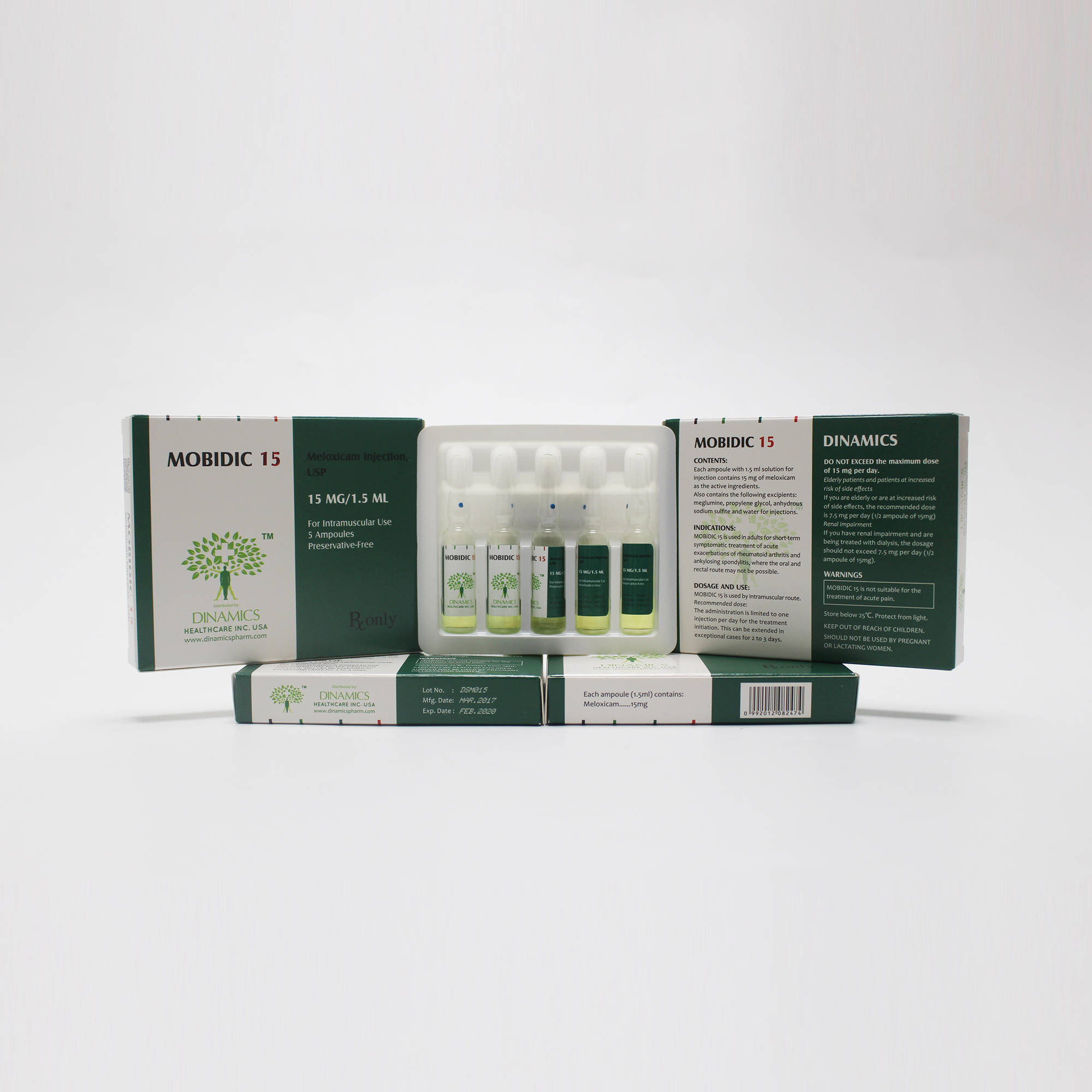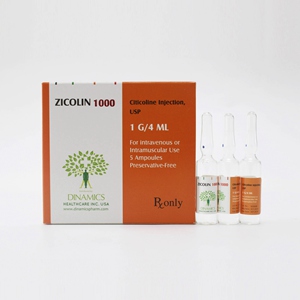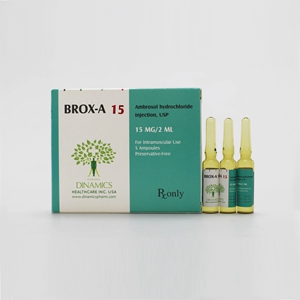Meloxicam Injection, USP
Contents of the pack and other information
What MOBIDIC 15 contains
• Each active substance is meloxicam. One ml of solution contains 10 mg of meloxicam. One ampoule with 1.5 ml solution for injection contains 15 mg of meloxicam.
• The other ingredients are: meglumine, propylene glycol, anhydrous sodium sulfite and water for injections.
What MOBIDIC 15 looks like and contents of the pack
Clear, yellow to greenish-yellow solution, practically free from particles.
Clear glass ampoule with total fill capacity of 2 ml, containing 1.5 ml solution for injection.
Each box contains 1 tray with 5 ampoules.
DESCRIPTION
1. What MOBIDIC 15 is and what it is used for
This medicine contains the active substance of meloxicam, which belongs to a group of medicines called non-steroidal anti-inflammatory drug (NSAID), with anti-inflammatory, analgesic and antipyretic properties.
MOBIDIC 15 is used in adults for short-term symptomatic treatment of acute exacerbations of rheumatoid arthritis and ankylosing spondylitis, where the oral and rectal route may not be possible.
2. What you need to know before you take MOBIDIC 15 Do not use MOBIDIC 15:
-if you are allergic to meloxicam or any of the other ingredients of this medicine
-during the third trimester of pregnancy
-in children and adolescents under 18 years old
-if you are allergic to acetylsalicylic acid or other anti-inflammatory drugs (NSAIDs)
-if you have had one of the following symptoms after taking acetylsalicylic acid or other NSAIDs:
• asthma
• nasal obstruction due to small swellings of the nasal mucosa (nasal polyps)
• hives
• swelling of face, tongue or throat; breathing difficulties; swallowing difficulties (angioedema)
-if you have ever had, bleeding or perforation of the stomach or intestine, after treatment with NSAIDs
-if you have ulcer or bleeding from the stomach or intestines
-if you have a history of recurrent ulcers or bleeding in the stomach or intestines (ulcer or bleeding that occurred at least twice)
-if you have severely impaired liver function
-if you have severely impaired kidney function which is not being treated with dialysis
-if you have recent bleeding in the brain (cerebrovascular haemorrhage)
-if you have severe heart failure
-if you have bleeding disorders or ongoing treatment with medicines used to prevent blood clotting
Warnings and Precautions
MOBIDIC 15 is not suitable for the treatment of acute pain.
Talk to your doctor or pharmacist before taking MOBIDIC 15:
•if you have ever suffered from esophagitis (inflammation of the gullet), gastritis (inflammation of the stomach) or any other gastro-intestinal disease, such as ulcerative colitis, Crohn's disease
•if you suffer from heart disease.
- Medicines such as meloxicam may be associated with a small increased risk of heart attack ("myocardial infarction") or stroke. Any risk is more likely with high doses used and prolonged treatment. Do not exceed recommended doses
or duration of treatment.
- If you have heart problems, have had a previous stroke or think that you might be on risk of these conditions (for example if you have high blood pressure, diabetes or high cholesterol or are a smoker), you should discuss your treatment with your doctor or pharmacist.
• if you have skin problems.
-Potentially life-threatening skin rashes (Stevens-Johnson syndrome, toxic epidermal necrolysis) have been reported with the use of meloxicam, appearing initially as reddish target-like spots or circular patches often with central blisters on the trunk. Additional signs to look for include ulcers in the mouth, throat, nose, genitals and conjunctivitis (red and swollen eyes). These potentially life-threatening skin rashes are often accompanied by flu-like symptoms. The rash may progress to widespread blistering or peeling of the skin. The highest risk for occurrence of serious skin reactions is within the first weeks of treatment.
-If you have developed Stevens-Johnson syndrome or toxic epidermal necrolysis with the use of meloxicam, you must not be re-started on meloxicam at any time.
-If you develop a rash or these skin symptoms, seek immediate advice from a doctor and tell her/him that you are taking this medicine.
• if you have impaired liver or kidney function.
• if you are an elderly.
• if you have decreased blood volume (hypovolemia), which can happen if you have serious blood loss or burns, surgery or low fluids intake.
• if you have diabetes or take medicines known to increase the levels of potassium in the blood. Your doctor may monitor your progress during the treatment.
Meloxicam may hide the symptoms of infection (like the fever). If you think you have an infection, you should consult your doctor.
Other medicines and MOBIDIC 15
Tell your doctor or pharmacist if you are using, have recently used or might use any other medicines.
The following medicines can affect or be affected by MOBIDIC 15:
•other NSAIDs and acetylsalicylic acid
•corticosteroids (drugs used to reduce inflammation and allergic reactions)
•anticoagulants, e.g. warfarin or heparin (medicines used to prevent blood clotting)
•thrombolytics (drugs that break up blood clots)
•selective inhibitors of serotonin reuptake inhibitors (SSRIs) (used in the treatment of depression)
•diuretics. Your doctor may need to monitor your kidney function if you are taking diuretics.
•medicines used to treat high blood pressure and heart disease (e.g. ACE inhibitors, Angiotensin-II Antagonists, beta-blockers)
•ciclosporin (used after organ transplantation, in severe skin disorders, diseases such as rheumatoid arthritis or nephrotic syndrome)
•tacrolimus (used after organ transplantation)
•contraceptive intrauterine device (IUD, coils)
•lithium (used to treat mood disorders)
•methotrexate (used for treating certain tumors and skin diseases and severe uncontrolled active rheumatoid arthritis)
•cholestyramine (used to lower cholesterol)
Pregnancy, breast-feeding and fertility
If you are pregnant or breast-feeding, think you may be pregnant or are planning to have a baby, ask your doctor or pharmacist for advice before taking this medicine.
Pregnancy
The use of this medicine should be avoided during the first 6 months of your. It should only be prescribe to you it if your doctor considers it clearly necessary. During the last 3 months of your pregnancy, you should never use Meloxicam, as this can have serious consequences for your child, even with a single dose.
Breast-feeding
Meloxicam passes into breast milk. Meloxicam is therefore not recommended during breast-feeding.
Fertility
Meloxicam may make it more difficult to get pregnant. You should inform you doctor if you have problems becoming pregnant.
Driving and Using Machines
Visual disturbances, drowsiness, vertigo (dizziness) may occur with this product. In this case do not drive or use machines.
DIRECTION
1.How to take MOBIDIC 15
Always use this medicine exactly as your doctor or pharmacist has told you. Check with your doctor or pharmacist if you are not sure.
Meloxicam is used by intramuscular route. The injection should only be performed by a healthcare professional. This medicine will be injected slowly into the buttock. If you receive more than one injection, your doctor will make injections, alternating right and left side.
If you have a hip replacement, your doctor should inject into the opposite side. If you experience severe pain at the time of injection, your doctor should stop the administration.
Recommended dose:
The administration is limited to one injection per day for the treatment initiation. This can be extended in exceptional cases (when administration by mouth or rectally is not possible) for 2 to 3 days.
DO NOT EXCEED the maximum dose of 15 mg per day.
Elderly patients and patients at increased risk of side effects
If you are elderly or are at increased risk of side effects, the recommended dose is 7.5 mg per day (1/2 ampoule of 15mg)
Renal impairment
If you have renal impairment and are being treated with dialysis, the dosage should not exceed 7.5 mg per day (1/2 ampoule of 15mg).
If you use more MOBIDIC 15 than you should
If you have used too much of meloxicam, contact your doctor or go immediately to the nearest hospital.
2. Possible side effects
Like all medicines, this medicine can cause side effects, although not everybody gets them.
Stop using Meloxicam and consult a physician or go to the nearest hospital immediately if you notice:
• allergic reactions, which may take the form of:
-severe skin reactions, including blistering, red or purple marks or peeling of the skin. It can also affect the mouth, eyes and other mucous membranes (Stevens-Johnson syndrome, toxic epidermal necrolysis or Erythema multiforme). These side effects are very rare (may affect up to 1 in 10,000 people).
-swelling of the skin or mucosa, such as swelling around the eyes, face and lips, mouth or throat, possibly making it difficult to breathe (angioedema), and swelling of the ankles or legs (oedema) (may affect up to 1 in 100 people).
-shortness of breath or asthma attack (may affect up to 1 in 1,000 people)
•inflammation of the liver which can cause: yellowing of the skin or eyeballs , abdominal pain, loss of appetite (may affect up to 1 in 10,000 people)
•any adverse effects of the digestive tract.
- bleeding from the digestive tract (black stools), ulcer formation or perforation (causing abdominal pain) can sometimes be severe and potentially fatal, especially in the elderly (may affect up to 1 in 1,000 people).
Other side effects:
Very common (may affect more than 1 in 10 people)
•indigestion
•feeling sick and vomiting
•stomach pain
•constipation
•flatulence
•loose stools (diarrhoea)
Common (may affect up to 1 in 10 people)
•headache
•injection site mass, pain at the injection site
Uncommon (may affect up to 1 in 100 people)
•dizziness
•somnolence
•anemia (reduced hemoglobin concentration)
•increased blood pressure
•flushing
•sodium and water retention
•increased levels of potassium
•belching
•inflammation of the stomach or of the mouth
•rash
•abnormalities in liver or renal function tests . Your doctor can detect these anomalies by a blood test.
Rare (may affect up to 1in 1,000 people)
•mood altered
•nightmares
•abnormal blood counts.
•ringing in the ears
•palpitations
•inflammation of the esophagus
•hives
•vision disturbances, including blurred vision and inflammation of the whites of the eyes, eyelids
•inflammation of the large intestine
Very rare (may affect up to 1 in 10,000 people)
•acute renal failure especially in patients with risk factors such as heart disease or kidney disease
•agranulocytosis (complete loss of specific types of white blood cells). This can cause:
- sudden fever, - sore throat,
- infections. If you get any of these, you should see a doctor to do a blood test to rule out shortage of white blood cells.
Not known (frequency cannot be estimated from the available data)
•confusion
•disorientation
•serious allergic reactions with symptoms as fever, swelling, sudden drop in blood pressure, shortness of breath and skin reactions
•skin rashes caused by exposure to sunlight
INGREDIENTS
Contents of the pack and other information
What MOBIDIC 15 contains
• Each active substance is meloxicam. One ml of solution contains 10 mg of meloxicam. One ampoule with 1.5 ml solution for injection contains 15 mg of meloxicam.
• The other ingredients are: meglumine, propylene glycol, anhydrous sodium sulfite and water for injections.
What MOBIDIC 15 looks like and contents of the pack
Clear, yellow to greenish-yellow solution, practically free from particles.
Clear glass ampoule with total fill capacity of 2 ml, containing 1.5 ml solution for injection.
Each box contains 1 tray with 5 ampoules.
STORE
How to store MOBIDIC 15
Keep this medicine out of the sight and reach of children. Store below 25°C. Protect from light.
Do not use this medicine after the expiry date ‘EXP’ shown on the container. The expiry date refers to the last day of that month.
Do not throw away any medicines via wastewater or household. Ask your pharmacist how to throw away medicines you no longer use. These measures will help protect the environment.




